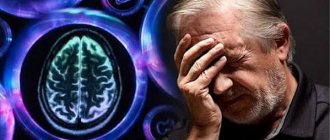29 Jun 2021 at 12:16 MRI of the head in Tushino 17132
If you often find yourself forgetting things and becoming too suspicious of others, you may need medical advice. Dementia is often perceived as analogous to memory loss. However, this disease, even in its acute form, is a common symptom of age-related dementia, the development of which can be stopped.
Causes of dysposophobia
Dyspophobia is the fear of parting with things. Plyushkin syndrome, as well as its causes, continue to be studied. So far, psychologists have identified the following reasons for the development of dyspozophobia (syllogomania):
- Individual characteristics. Greed and frugality can lead to hoarding. Other people do not know how to part with things due to their vulnerability and sentimentality (they rarely bring junk home, but cannot get rid of old things because they value them as memories).
- Maladjustment and unconscious isolation. People who have not found their place in the world try to isolate themselves from society with the help of garbage. Mountains of garbage and an unpleasant smell are repulsive; a person is left alone with himself and his illness.
- Personal psychotrauma. People who have had to live in conditions of poverty, hunger or shortages are more prone to hoarding than others.
- Heredity. But this is not about genetics, but about the example of parents. If from an early age a child observes his parents’ hoarding, then he learns this model of behavior as the norm.
- Difficult childhood. Children who lack love, attention, and gifts from their parents fall into the risk group for hoarding as adults. They are trying to fill the gap, to give themselves what their parents did not give.
- Psychotrauma, tragedy. Depression and severe stress can trigger hoarding behavior. For example, a patient may keep things that remind him of a deceased or departed person.
- Loneliness. Some people think that things will replace their friends, real communication.
- Organic disorders, pathologies. Hoarding can be a consequence of traumatic brain injury, diseases of the brain and nervous system, surgery or oncology.
- Mental disorders and mental disorders due to alcoholism and other bad habits.
- Senile age. Older people are more likely to suffer from hoarding syndrome; the disease is combined with senile dementia.
This is interesting! The disease got its name by association with the main character of the novel “Dead Souls”. Plyushkin suffered from collecting syndrome. He constantly brought home trash and could not part with anything; it seemed to him that all this would be useful in the future.
A story of all-consuming avarice
Every day he walked along the streets of his village, looked under the bridges, under the crossbeams and everything that he came across: an old sole, a woman’s rag, an iron nail, a clay shard - he dragged everything to him and put it in the pile that Chichikov noticed in the corner of the room…
On city streets you can often meet unkempt people carrying various junk from local dumps in a checkered bag. Usually such characters are mistaken for homeless people, but not every trash bin dweller is homeless. You may have met a person with pathological hoarding disorder, which affects 2-6% of the world's population. Syllogomania is characterized by a persistent reluctance to throw away property or part with it, regardless of its real value. Pathology can lead to real problems both for the patient and for his environment.
Many people are familiar with the above from the school curriculum. Do you remember the landowner Plyushkin from Gogol’s “Dead Souls”? It was this disease that the character in the book suffered from. Nikolai Vasilyevich in his work perfectly described the principle of syllogomania. According to the plot, the hero collects all kinds of garbage, drags it into the house and turns his possessions into a landfill for household waste. The windows in the huts are broken, drafts are blocked with rags, the roofs of the houses look like a sieve, and the courtyard fence is all covered with green mold.
The buyer of souls, Chichikov, found Plyushkin in a woman's cap, rags of a tramp and with a beard that looked like a brush for cleaning horses. The character saves in order to save. He either does not use all his “finds” at all, or uses them with minimal expenditure. He carefully stores what he finds within his habitat. But why was he engaged in this meaningless activity? Let's figure it out.
How does Plyushkin syndrome manifest itself?
Most often, two forms of the syndrome occur: the acquisition of unnecessary things and the inability to throw away what a person no longer uses. However, these are not the only manifestations of the disease. Modern psychologists have identified several more types of the disease:
- vintageism - cluttering the house with antiques;
- pseudo-collecting - a person collects everything without delving into a narrow topic;
- usefulness - storing old and torn things, broken equipment and other items that may be useful somewhere and someday;
- conservatism - cluttering the house with jars.
Let's take a closer look at the three classic forms of the syndrome: storing unnecessary things, collecting junk, hoarding pets.
Storing unnecessary things
A person is guided by two thoughts: “what if it’s useful (I’ll lose weight, I’m not using it for its intended purpose, what if I get fat, what if I’m going on a hike, etc.)” and “this is dear to me as a memory.” Sometimes the patient dismantles old things and stores them partially, for example, leaving working spare parts for non-working equipment.
Collecting discarded items
A person collects everything he sees. Some people don’t hesitate to go through trash cans, while others accept things as gifts. A person collects both serviceable and usable things, as well as faulty, torn, broken ones. But the point is that with pathological collecting, a person does not need these things, no matter what they are. He dumps them in a pile and forgets about his finds.
Pet hoarding
A non-standard form of manifestation of the disease is pathological hoarding of animals (few people understand that this is a type of Plyushkin syndrome). The patient sets up an animal shelter from his home. But, as a rule, animals are not treated and do not receive the necessary medical care, and the apartment is unsanitary. As a result, it becomes unsuitable for either human life or animal life.
Plyushkin syndrome and shopaholism
Sometimes these phenomena are confused and considered one and the same, but these are two different psychological problems. A shopaholic spends money on shopping, this is akin to drug addiction, alcoholism (it’s not for nothing that the names are similar). Plyushkin syndrome is more similar to obsessive-compulsive behavior than addiction.
It is important! Shopaholism and Plyushkin syndrome are similar; the first can easily develop into the second.
Healing with love
What should the relatives and neighbors of the modern Plyushkins do? After all, they have to endure for years an unpleasant smell, dirt, and sometimes hordes of cockroaches and mice, which naturally feel at home in such apartments. In addition, such a neighborhood can pose a direct danger. After all, for example, if there is a fire in a room full of garbage, it will be impossible to put out the fire; such apartments will burn to the ground.
Ideally, the patient should be consulted by a psychiatrist or at least consult a psychologist. In advanced cases, the doctor may prescribe special medications that stabilize the patient’s condition. With regular use of medications, a state of remission often occurs, and the person returns to a normal lifestyle.
And in the initial stages of the disease, psychiatrists advise trying to come to an agreement with the collector, directing his passion for collecting in a peaceful direction. For example, for starters, you can advise him to collect something specific or at least of the same type. You can get him interested in collecting culinary recipes - then time will be spent on selecting them, sticking them in special albums, as well as watching TV shows on the topic and recording the information received in special notebooks.
Instead of living cats, you can advise the “collector” to collect postcards, stamps, labels and other things with the image of this animal. If a person drags old newspapers and magazines into the house, it will be useful to stipulate in advance that printed materials are selected only on a specific topic. It would be nice to regularly help your relative with cleaning.
Who is susceptible to phobia
The following categories of people are at risk:
- Alcoholics. Sometimes a person in the morning cannot remember where this or that thing came from in his house.
- Outcasts. A person who is not accepted by society begins to look for a solitary hobby. Finding a hobby can lead to pathological hoarding.
- Book lovers. A literature connoisseur will not be able to pass by a bookstore or an advertisement that someone is giving away books, and he also cannot throw away unnecessary newspapers, old magazines and books. Gradually they litter the house.
- Sentimental people. Every thing in their house reminds of something pleasant, but often the person who collects and stores things cannot remember what exactly the thing reminds of.
- Greedy people. Because of stinginess and greed, they feel sorry for throwing things away or giving them to those in need.
Treatment
Doctors and psychologists recommend pharmacology and individual work with patients. It is not worth using the methods separately if the patient wants to achieve an effect.
Due to the nature of clients, therapists are often advised to visit them in their homes. During the trips the following purposes are pursued:
- Understand the extent of hoarding.
- Develop a plan that takes into account all the nuances of the patient’s character.
- Help the hoarder socialize.
In such cases, a specialist should find out why a person begins to collect things. During treatment, the skills of giving up unnecessary things, making decisions, cleaning, relaxation methods and the principles of leading a healthy lifestyle are instilled. In some cases, hospitalization is required. Interestingly, watching lectures on hoarding and generally increasing patient awareness showed good results in both the short and long term. It is better not to self-medicate, but to seek the help of specialists who will prescribe a treatment plan. Take care, reader. Don't accumulate trash and be in harmony with yourself.
Stages of pathological hoarding
Three stages of disease development can be distinguished:
- A person begins to buy items that are not essential. The patient cannot ignore promotions and sales, advertisements like “I’ll give it away for free.”
- At this stage, the patient not only buys unnecessary items on sale, but also brings home trash from the street and garbage dumps.
- The patient's home turns into a dump, creating unsanitary and unsuitable conditions for living.
At the initial stage, the situation in the patient’s home looks like a slight disorder. You might think that a person is very passionate about some hobby, creativity, or he simply has no time to tidy up. But every month the condition of the house is getting worse. At the same time, the patient's condition worsens.
What else, besides hoarding itself, is accompanied by Plyushkin syndrome (signs):
- fear of losing, giving away or throwing away an item;
- the emergence of new useless things that cannot be used;
- pathological greed and frugality;
- loss of orientation in one’s own home (a person does not know where everything is, and what is in his house);
- constant visits to landfills, markets, sales;
- viewing advertisements “I’ll give it to good hands”;
- indifference to one’s appearance (the patient stops taking a bath or combing his hair);
- avoidance of communication, meeting people;
- moving things from one pile to another.
Complications
Lack of patient care and necessary treatment for Diogenes syndrome leads to dire consequences. The main causes of complications are social isolation and neglect of health and appearance. Eating spoiled foods, the presence of stray animals and their excrement, and failure to comply with hygiene procedures contribute to the development of infectious diseases (gastrointestinal, respiratory, skin). The pathological stinginess of patients is manifested by saving on medications and doctor visits. Protracted infections and exacerbations of diseases of internal organs under conditions of isolation result in death.
Read also: What is gold leaf
Ways to combat pathological hoarding
Treatment of obsessive-compulsive disorders is one of the most difficult tasks in psychology. Until now, no universal method has been invented to treat Plyushkin syndrome in order to get rid of the disorder forever. Treatment is aimed not so much at completely getting rid of habits, but at learning to live in peace with your habits. A psychologist helps the patient gain control over his condition, reduce the severity of the disease, and find the root cause.
Behind hoarding, like other OCD, lies the fear of losing control of a situation. What is caused by a traumatic past experience when a person felt powerless, lonely, helpless. And also behind the pathological syndrome there may be a fear of the future, fear of the unknown, fear of leaving the comfort zone, fear of change and the like. To identify the cause and work through psychological trauma, it is better to consult a psychotherapist. He will quickly find the cause of Plyushkin syndrome and tell you how to fight it.
Distracting attention
Hoarding, how to deal with it: you can try to convince the patient to give things to those in need, for example, to an orphanage or low-income families. This method is suitable for kind and compassionate people with the first or second stages of phobia.
Conversation
During a confidential conversation, the psychologist finds out what exactly frightens the patient. Together with the client, he finds out the root cause of hoarding and helps the patient understand his feelings and thoughts. After this, a plan is developed for correcting habits, thinking and attitudes towards the past.
Anti-example
Sometimes looking at yourself from the outside helps you realize the problem and want to change. You can film the life of the patient himself or show a film about the life of a person with a similar disorder. It is important to show not only the complexity and specificity of the situation in the present, but also the possible future, the consequences of such a lifestyle.
Anxious expectations
Already in the first wave of the pandemic in 2021, psychiatrists drew attention to changes in the mental health of the population. Lockdowns, other coronavirus restrictions, remote work, a person constantly being at home - all this has already provoked negative psychological effects. Add to this anxious expectations - fear of becoming seriously ill, fear for loved ones, the possibility of losing a job - and here it is, a set that places a heavy burden on the human psyche.
At the same time, some researchers have started talking about the increase in suicidal and depressive feelings among completely healthy citizens in different countries of the world. Moreover, data began to appear about increasing cases of domestic violence and divorce.
Photo © Pixabay
When a person gets sick, his anxious expectations intensify. The patient begins to monitor his condition, symptoms, temperature, and breathing with fear. No one wants to end up in a hospital under strict quarantine. Even more fears are caused by the possibility of developing severe complications, the use of ventilators and other procedures. Now doctors already know that the most severe psychological consequences occur precisely in patients who have undergone artificial ventilation.
Why is the syndrome dangerous?
Due to unsanitary conditions, people who are prone to hoarding often get sick. And their lifestyle is gradually turning into an asocial, reclusive one. The patient loses his ability to work and the ability to care for himself. Not only unsanitary conditions are created in the house, but also fire hazards. Over time, the person becomes completely disoriented and desocialized. He has problems in the main areas of his life: work, personal life, friends.
It is important! Often, due to the disorder, the patient loses his family and job, and becomes seriously ill. Therefore, you need to get rid of the disease as soon as possible.
Symptoms of vegetative-vascular dystonia in children and adults
There are no clearly distinguishable symptoms of vegetative-vascular dystonia. A disorder of the autonomic nervous system can manifest itself in different ways. Among its most common signs:
- Respiratory (respiratory): tachypne (rapid) breathing, inability to take a deep breath or exhale completely, unexpected deep breaths, chest congestion, feeling of lack of oxygen, attacks of shortness of breath (may resemble bronchial asthma), which appear due to overexertion, fear, fatigue.
- Cardiac (cardiac): tachycardia (rapid heartbeat), interruptions in heart function, cardiac arrest, chest pain.
- Thermoregulatory: increase/decrease in body temperature for unknown reasons.
- Dysdynamic: impaired blood circulation in tissues, surges in venous/arterial pressure.
- Psychoneurological: decreased performance, lethargy, weakness, increased fatigue, frequent headaches, irritability, dizziness, insomnia at night, drowsiness during the day, shuddering during sleep, sensitivity to weather changes.
- Sexual: anograsmia (impossibility of achieving orgasm while sexual desire persists), painful and frequent urination.
- Dyspeptic: disorders of the gastrointestinal tract (vomiting, belching, diarrhea, abdominal pain).
Thus, many symptoms of VSD relate to other diseases that are not related to the functioning of the brain and autonomic nervous system. However, their combination against the background of cardiovascular manifestations allows us to speak specifically about the development of vegetative dystonia. Symptoms of pathology in children and adults are the same.
If you notice similar symptoms, consult a doctor immediately. It is easier to prevent a disease than to deal with the consequences.
Alogia
Many patients with schizophrenia are laconic; they are characterized by low speech productivity, slowness in answering questions, and monosyllabic statements.
Alogy:
- Monosyllabic statements.
- Poverty of speech content.
- Delay in answering a question (“answering after a long pause”).
Traditionally, alogia is described in the structure of negative symptoms of schizophrenia. In our opinion, this rather complex psychopathological phenomenon is partly a consequence of the neurocognitive deficit characteristic of schizophrenia.
Return to Contents
Prevention
To reduce the risk of developing hoarding disorder, people over 45 years of age are advised to lead as active and healthy a lifestyle as possible. You need to eat right, go to the pool and gym. You should give up bad habits. In addition, you need to avoid stress and sleep at least 8 hours a day. It is advisable to find new hobbies and regularly perform exercises to develop memory.
Read more: How to overcome childhood fears?
In the video, psychotherapist Tatyana Skiba talks about the prevention of pathological hoarding syndrome:
Harmless hobby or illness
Daria, 32 years old: “My father is 68 years old.
For the last 7-8 of them, all he does is carry all sorts of rubbish home from dumpsters all day long. Unfortunately, our living and material conditions are cramped, so the four of us are forced to live in a small two-room apartment: my father, me, my husband and our son. And if my father doesn’t encroach on our room, he’s so filled his with “goodies” found in a landfill that he’s forced to make his way to his rookery (it’s hard to call THIS a bed) along a narrow path. What does he not have! Old broken bicycles, burnt irons, skis, sleds, boards, crates, boxes, worn-out clothes and shoes thrown away by someone, a guitar without strings... All this could somehow be tolerated if he had not recently begun to actively master for storage and other premises of the apartment. So, an ancient non-working refrigerator appeared in the kitchen (one of the neighbors put it on the staircase, and my father grabbed it), a tattered bread bin, some frying pans...
But our patience ran out when, coming home from work, we discovered that the entire corridor was filled with window glass! After all, it is unsafe, since a child lives in the apartment! Nowadays, many people install plastic windows and throw away the old ones. And the father is right there! To the question: “Why did you need these glasses?” he replied that someday he would build a greenhouse out of them at his dacha. And someday he will: fix all the broken irons and bicycles and attach strings to the guitar. But time passes, nothing like this happens, and it is clear that it will never happen. Meanwhile, the mountains of trash continue to grow..."










